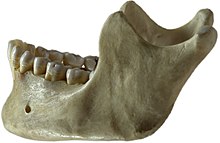Panga: Pagkakaiba sa mga binago
→External links: pagsasalin |
{{stub}}; pagsasalin ng ilang bahagi |
||
| Linya 1: | Linya 1: | ||
[[Image:Human_jawbone_front.jpg|right|thumb|Panga ng tao (kung tatanawin mula sa harapan).]] |
[[Image:Human_jawbone_front.jpg|right|thumb|Panga ng tao (kung tatanawin mula sa harapan).]] |
||
[[Image:Human_jawbone_left.jpg|right|thumb|Panga ng tao (kung tatanawin mula sa kaliwa).]] |
[[Image:Human_jawbone_left.jpg|right|thumb|Panga ng tao (kung tatanawin mula sa kaliwa).]] |
||
[[Image:Human_jawbone_top.jpg|right|thumb|Panga ng tao (kung tatanawin mula sa ibabaw).]] |
[[Image:Human_jawbone_top.jpg|right|thumb|Panga ng tao (kung tatanawin mula sa ibabaw).]] |
||
Ang '''panga''' ay maaaring dalawang nagsasalungatang kayarian bumubuo, o malapit sa pasukan, ng bibig. Maaari ding malawakang gamitin ang salitang '''panga''' sa kabuuan ng kayariang bumubuo sa arkong binubungan ng bibig at nagsisilbing pambukas at pansara ng bibig. |
|||
The term ''jaws'' is also broadly applied to the whole of the structures constituting the vault of the mouth and serving to open and close it. |
|||
==Arthropods== |
|||
In [[arthropod]]s, the jaws are [[chitin|chitinous]] and oppose laterally, and may consist in ''mandibles'', ''[[chelicerae]]'', or loosely, ''[[pedipalps]]''. |
|||
Their function is fundamentally for food acquisition, conveyance to the mouth, and/or initial processing (''mastication'' or ''chewing''). |
|||
==Vertebrates== |
|||
In most [[vertebrate]]s, the jaws are [[bone|bony]] or [[cartilage|cartilaginous]] and oppose vertically, comprising an ''upper jaw'' and a ''lower jaw''. |
|||
===Bones of the jaw=== |
|||
In vertebrates, the lower jaw, dentary or [[mandible]] is the mobile component that articulates at its posterior processes, or ''rami'' (singular ''ramus''), with the temporal bones of the [[skull]] on either side; the word ''jaw'' used in the singular typically refers to the lower jaw. |
|||
The upper jaw or [[maxilla]] is more or less fixed with the skull and is composed of two bones, the ''maxillae'', fused intimately at the [[anatomical position|median line]] by a [[suture]]; incomplete closure of this suture and surrounding structures may be involved in the malformation known as [[cleft palate]]. |
|||
The maxillary bones form parts of the roof of the mouth, the floor and sides of the [[nose|nasal cavity]], and the floor of the [[Orbit (anatomy)|orbit]] or ''eye socket''. |
|||
The jaws typically accommodate the [[tooth|teeth]] or form the bases for the attachment of a [[beak]]. |
|||
===The jaw in fish and amphibians=== |
|||
The vertebrate jaw probably originally evolved in the [[Silurian]] period and appeared in the [[Placodermi|Placoderm]] [[fish]] which further diversified in the [[Devonian]]. Jaws are thought to derive from the pharyngeal arches that support the [[gills]] in fish. The two most anterior of these arches are thought to have become the jaw itself and the hyoid arch, which braces the jaw against the braincase and increases mechanical efficiency. While there is no fossil evidence directly to support this theory, it makes sense in light of the numbers of pharyngeal arches that are visible in extant jawed (the [[Gnathostomata|Gnathostomes]]), which have seven arches, and primitive jawless vertebrates (the [[Agnatha]]), which have nine. |
|||
It is thought that the original selective advantage garnered by the jaw was not related to feeding, but to increased respiration efficiency. The jaws were used in the [[buccal pump]] (observable in modern fish and [[amphibians]]) that pumps water across the gills of fish or air into the lungs in the case of amphibians. Over evolutionary time the more familiar use of jaws (to humans), in feeding, was selected for and became a very important function in vertebrates. |
|||
===The jaw in reptiles=== |
|||
In [[reptile]]s, the [[mandible]] is made up of five bones. In the evolution of [[mammal]]s, four of these bones were reduced in size and incorporated into the ear. In their reduced form, they are known as the ''[[malleus]]'' and ''[[incus]]''; along with the more ancient ''[[stapes]]'', they are the ''[[ossicles]]''. This adaptation is advantageous, not only because a one-bone jaw is stronger, but also because the malleus and incus improve hearing. (However, reptiles tend to swallow prey whole because their pace of digestion is different than mammals, so multiple jaw bones may allow flexibility to expand the jaws around prey.) |
|||
==Sa mga artropods== |
|||
Sa mga [[arthropod|artropod]], ang panga ay [[chitin|chitinous]] at nagsasalungatang pagilid, at maaaring bumuo sa mga [[pangibabang panga|mandible]], [[chelicerae]], o sa maluwag na kahulugan, mga [[pedipalp]]. Pangunahing tungkulin nito ang pagkamit ng pagkain, paghahatid sa bibig, at pagnguya. |
|||
==Sa mga vertebrata== |
|||
Sa karamihan ng mga [[vertebrata]], ang panga ay mabubuto o makartilahinong (binubuo ng malalambot na buto) at nagsasalungatan sa paraang patayo (bertikal), na binubuo ng [[pangitaas na panga]] at ng [[mandible|pangibabang panga]]. |
|||
==Mga ugnayang panlabas== |
==Mga ugnayang panlabas== |
||
| Linya 38: | Linya 16: | ||
[[Category:Tao]] |
[[Category:Tao]] |
||
[[Category:Hayop]] |
[[Category:Hayop]] |
||
{{stub}} |
|||
[[ar:فك]] |
[[ar:فك]] |
||
Pagbabago noong 20:35, 13 Oktubre 2007



Ang panga ay maaaring dalawang nagsasalungatang kayarian bumubuo, o malapit sa pasukan, ng bibig. Maaari ding malawakang gamitin ang salitang panga sa kabuuan ng kayariang bumubuo sa arkong binubungan ng bibig at nagsisilbing pambukas at pansara ng bibig.
Sa mga artropods
Sa mga artropod, ang panga ay chitinous at nagsasalungatang pagilid, at maaaring bumuo sa mga mandible, chelicerae, o sa maluwag na kahulugan, mga pedipalp. Pangunahing tungkulin nito ang pagkamit ng pagkain, paghahatid sa bibig, at pagnguya.
Sa mga vertebrata
Sa karamihan ng mga vertebrata, ang panga ay mabubuto o makartilahinong (binubuo ng malalambot na buto) at nagsasalungatan sa paraang patayo (bertikal), na binubuo ng pangitaas na panga at ng pangibabang panga.
Mga ugnayang panlabas
![]() Ang lathalaing ito ay isang usbong. Makatutulong ka sa Wikipedia sa pagpapalawig nito.
Ang lathalaing ito ay isang usbong. Makatutulong ka sa Wikipedia sa pagpapalawig nito.
